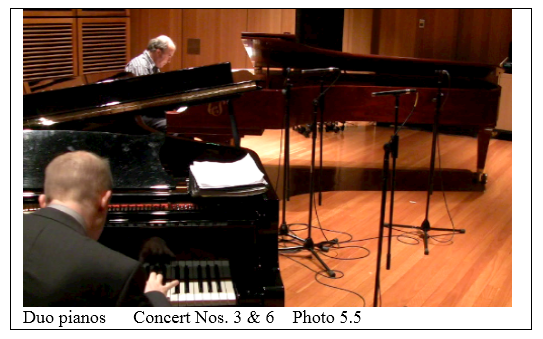cues related to the directivity, that is, visual and sonic cues of where the sounds are coming from are needed to thoroughly identify differences in sounds of instruments belonging to a similar class. Similarly, as previously mentioned, Galembo’s research343 found that experienced pianists had difficulty in identifying the sounds of pianos they knew very well, whilst the pianos were played by another pianist, out of view, behind screens. The effect of the screen used in the Piano Contrast concerts on the timbre of the pianos sounds will be examined with aural examples later in this chapter.

The pianists in the duo piano concerts, Simon Tedeschi and Kevin Hunt were each of differing stylistic backgrounds, and each was well known to the audiences for their disparate stylistic genres of jazz and classical pianism. They had previously performed in many concerts as a duo, and were known for their mixture of classical and jazz styles in their performance repertoires and recordings, so there was an added intrigue as to how each pianist would play the Stuart piano. As stated earlier in this chapter, the styles and pianistic mannerisms of each pianist probably did influence the audiences to conclusively ‘say’ that the Stuart piano sounded more suited to jazz style than the Steinway, and that Hunt’s style was more suited to the Stuart piano than Tedeschi’s. Audiences favoured the Stuart sound to be more suited to jazz style and the Steinway sound to be more suited to classical style, as well as Kevin Hunt’s playing style to be more suited to the Stuart piano and Simon Tedeschi’s to be more suited to the Steinway.
Evaluating Overall Perceptions – 6 concerts.
The verbal attributes used in the survey questions as multiple-choices provided the relational measure344 to assist the survey participant’s discernment in describing the sounds of the Stuart and Steinway. The frequency at which the verbal attributes were used in the audience responses both as comments and as answers indicated the audience perception. The same set of attribute multiple-choices in each survey question was repeated for each piano sound so the use of a particular attribute in the responses could be categorized as either identifying the Stuart or Steinway sound. In compiling the survey responses, the number of responses that used an attribute to describe a piano sound was tallied against the number of times that same attribute was used to describe the other piano sound. The wider the differential of attribute use in responses, e.g. 66%STU ‘bright’ verses 40%STE’bright’, established
343 3Galembo.
344 2 Hajda.




